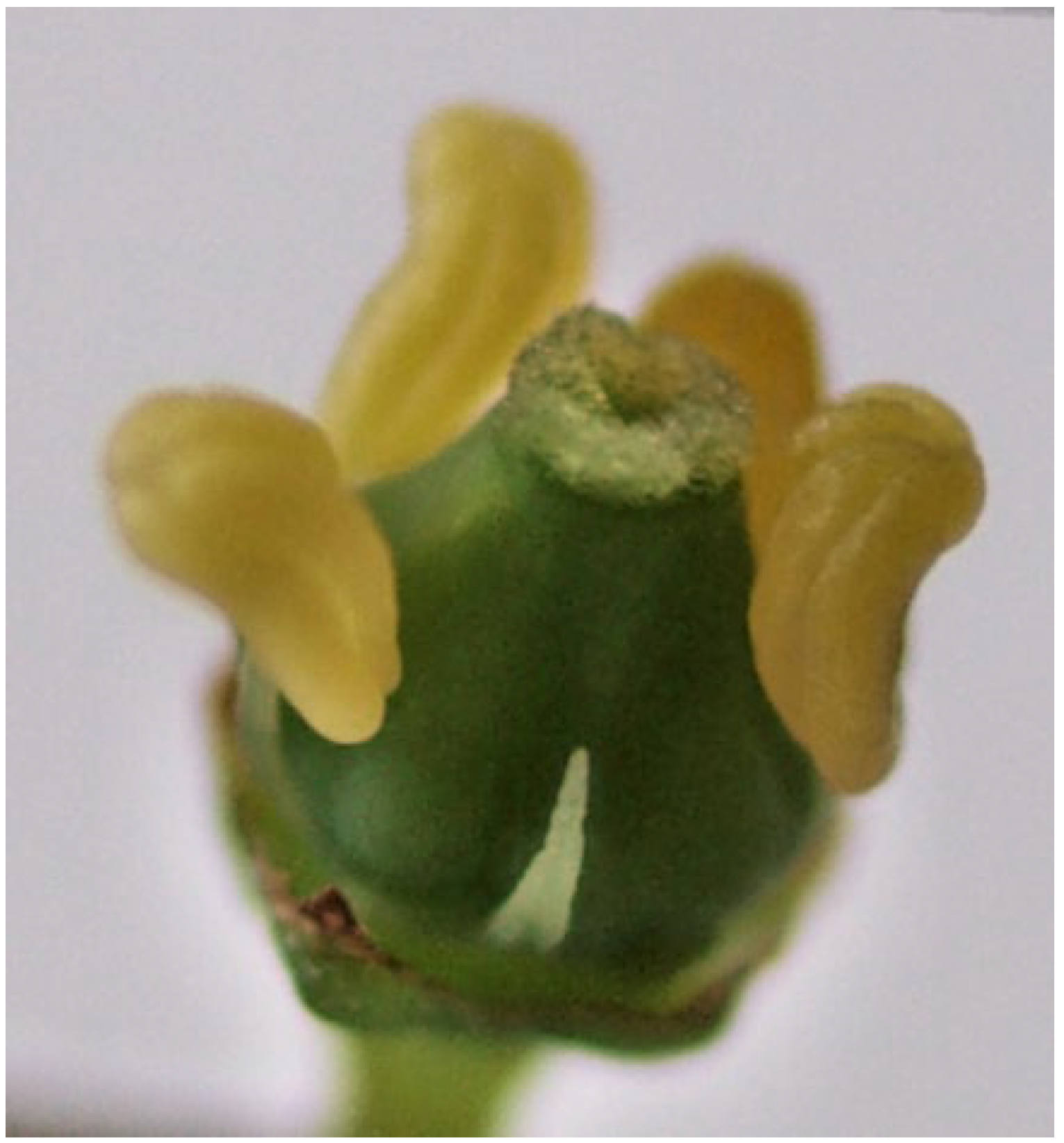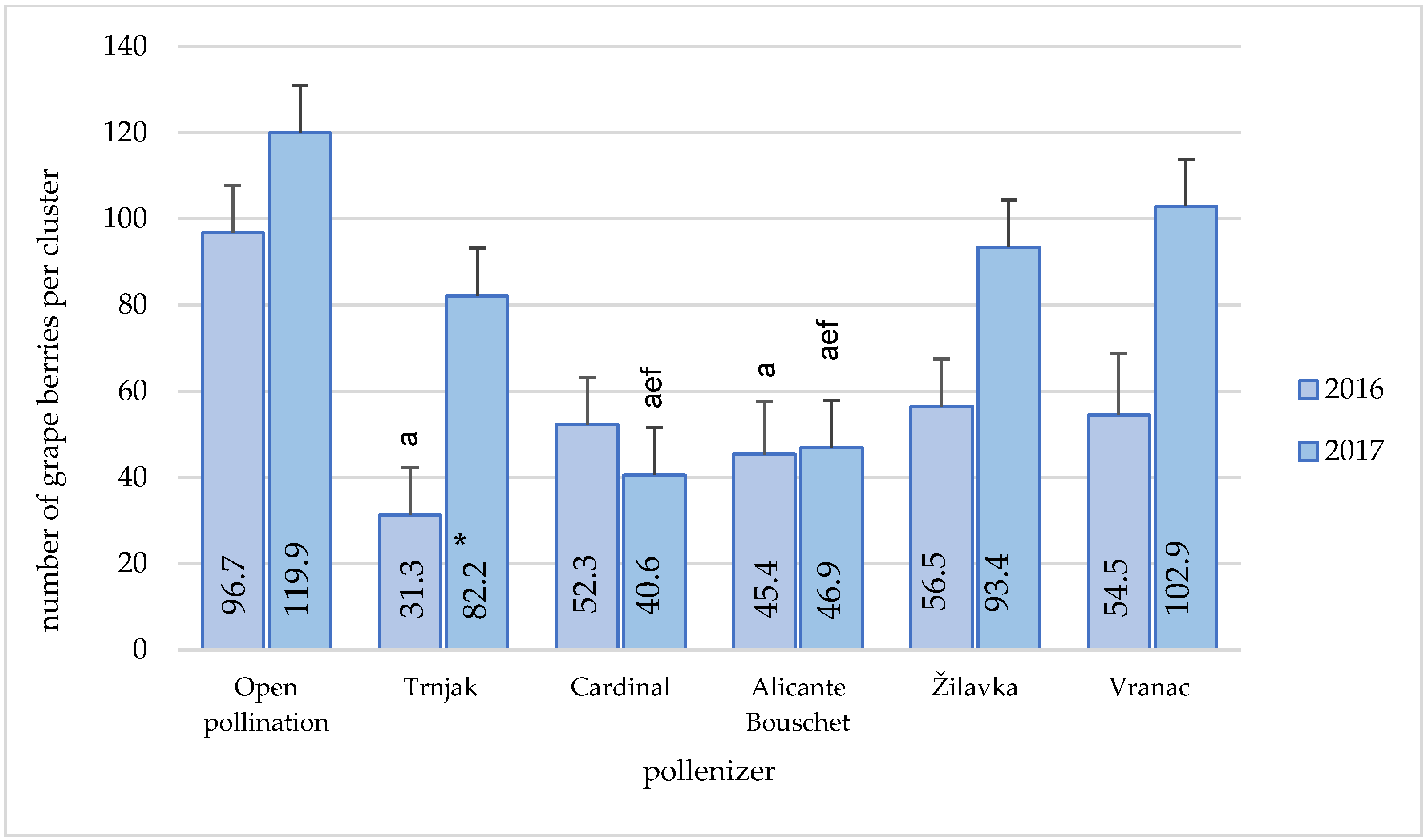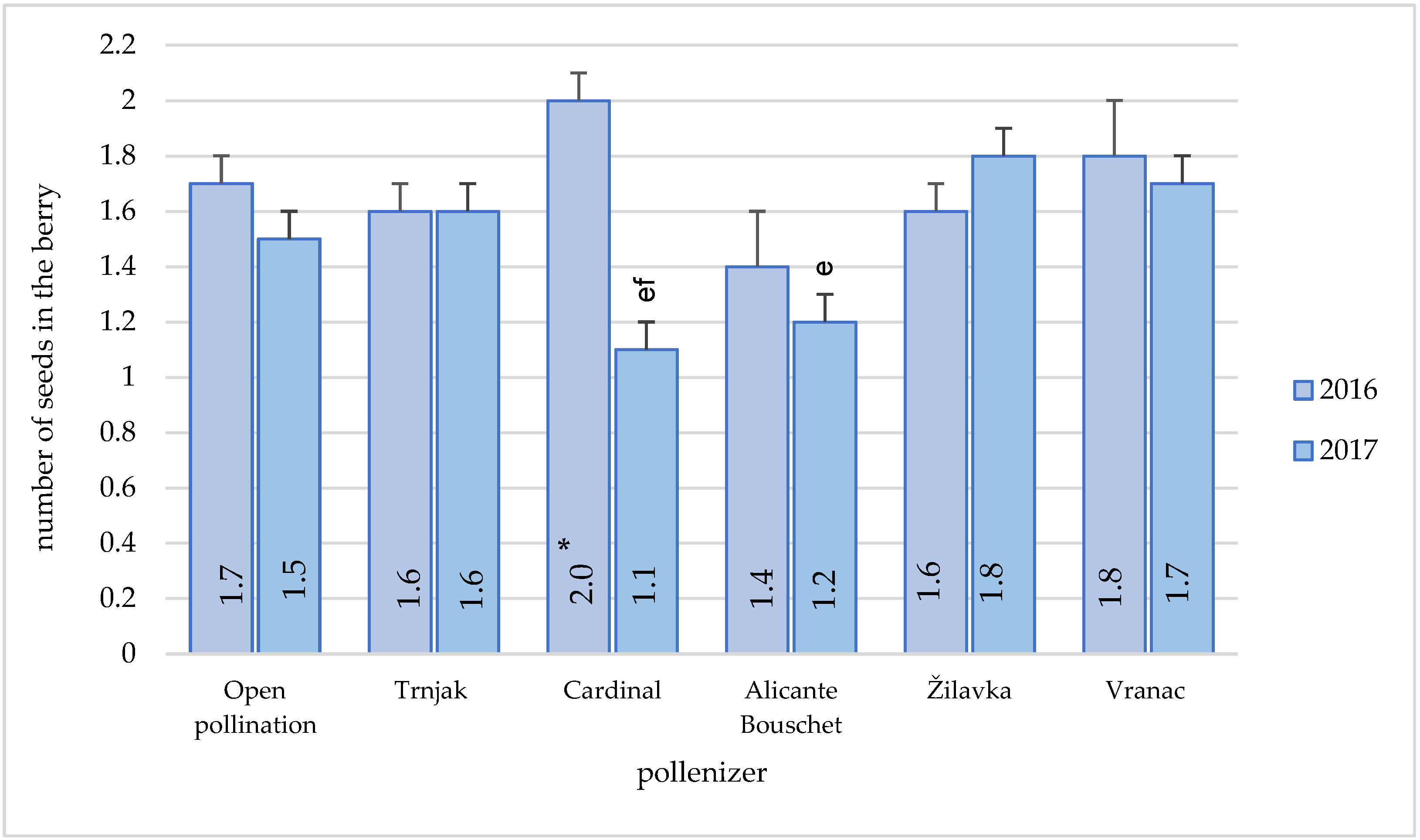Influence of Interaction Effects of the Different Pollenizers on the Blatina Variety (Vitis vinifera L.) Grape Cluster and Seed Characteristics
Abstract
:1. Introduction
2. Results
2.1. Pollen Germination
2.2. Cluster and Berry Characteristics
2.3. Seed Development
3. Discussion
3.1. Pollen Germination
3.2. Cluster and Berry Characteristics
3.3. Seed Development
4. Materials and Methods
4.1. Climatic Conditions
4.2. Plant Material
4.3. Pollination Treatments
4.4. Fruit Quality Characteristics
4.5. Statistical Analysis
5. Conclusions
Author Contributions
Funding
Data Availability Statement
Acknowledgments
Conflicts of Interest
References
- Costantini, L.; Moreno-Sanz, P.; Nwafor, C.C.; Lorenzi, S.; Marrano, A.; Cristofolini, F.; Gottardini, E.; Raimondi, S.; Ruffa, P.; Gribaudo, I.; et al. Somatic variants for seed and fruit set in grapevine. BMC Plant Biol. 2021, 135, 1–33. [Google Scholar] [CrossRef]
- Sabir, A.; Kilinc, S.; Sabir, F. Qualitative and quantitative response of early ripening table grape cultivars (Vitisvinifera L.) to pollination treatments under controlled growing condition. Erwerbs-Obstbau 2020, 62, 75–80. [Google Scholar] [CrossRef]
- Sabir, A. Xenia and metaxenia in grapes: Differences in berry and seed characteristics of maternal grape cv. ‘Narince’ (Vitisvinifera L.) as influenced by different pollen sources. Plant Biol. 2014, 17, 567–573. [Google Scholar] [CrossRef]
- Kevan, P.; Blades, D.; Posluszny, A.; Ambrose, J. Pollen dimorphisam and dioecy in Vitisaestivalis. Vitis 1988, 27, 143–146. [Google Scholar]
- Silva, P.R.; Bione, N.; Silva, N.; Paglaini, M.S. Meiotic behavior of the Brazilian table grape cultivar rubi (Vitisvinifera L.) with a high proportion of seed less berries. Vitis 2001, 40, 1–4. [Google Scholar]
- Caporali, E.; Spada, A.; Marziani, G.; Failla, O.; Scienza, A. The arrest of development of abortive reproductive organs in the unisexual flower of Vitisvinifera ssp. silvestris. Sex. Plant Reprod. 2003, 15, 291–300. [Google Scholar] [CrossRef]
- Slimane-Harbi, M.B.; Chabbouh, N.; Snoussi, H.; Bessis, R.; Gazzah, M. Etude du germoplasme de vignesautochtones de Tunisie. Precisions sur I’origine du millerandage du “Razzegui”. Bull. O.I.V. 2004, 77, 487–501. [Google Scholar]
- Abreu, I.; Costa, I.; Oliveria, M.; Cunha, M.; De Castro, R. Ultrastructure and germation of Vitisvinifera L. cv Loureiropollen. Protoplasma 2006, 228, 131–135. [Google Scholar] [CrossRef]
- Gallardo, A.; Ocete, R.; Angeles Lopez, M.; Lara, M.; Rivera, D. Assessment of pollen dimorphisim in populations of Vitisvinifera L. subsp. sylvestris (Gmelin) Hegi in Spain. Vitis 2009, 48, 59–62. [Google Scholar]
- Najmaddin, C.; Khatijah, H.; Maideen, H. Comparative study on the anatomy and palynology of the three variety of Vitisviniferavarity (family Vitaceae). Afr. J. Biotechnol. 2011, 10, 16866–16874. [Google Scholar]
- Sabir, A.; Sabir, F.; Kara, Z.; Yasin, G.; Mohammed, O.J.M.; Jawshle, A.I.M.; Kus, A.D. Berry set and Quality Repsonse of Soilless grown “Prima” grapes to foliar inflorescence pulverization of various substances under glasshouse condition. Erwerbs-Obstbau 2019, 61, 47–51. [Google Scholar] [CrossRef]
- Jovanović-Cvetković, T.; Mićić, N.; Đurić, G.; Cvetković, M. Pollen morphology and germination of indigenous grapevine cultivars Žilavka and Blatina (Vitisvinifera L.). AgroLife Sci. J. 2016, 5, 105–109. [Google Scholar]
- Jovanović-Cvetković, T.; Mijatović, D.; Grbić, R. Effect of climatic parameters on uvological characteristics of variety “Blatina”. Ann. Univ. Craiova Agric. Montanology Cadastre Ser. 2016, 46, 178–184. [Google Scholar]
- Sabir, A.; Kucukbasmaci, H. Agronomic response of ‘Michele palieri’ (Vitisvinifera L.) table grape to intraspecific diploid and interspecific tetraploid pollinizers. Sci. Hortic. 2020, 72, 109589. [Google Scholar] [CrossRef]
- Denney, J.O. Xenia includes metaxenia. Hortic. Sci. 1992, 27, 722–728. [Google Scholar] [CrossRef] [Green Version]
- Milutinović, M.; Nikolić, D.; Fotirić, M.; Rakonjac, V. The relation between pollen functional ability and fruit set in grapevine (Vitis sp.). Genetika 2000, 32, 81–87. [Google Scholar]
- Kimura, P.H.; Ükamoto, G.; Hirano, K. Artificial pollination in Vitiscoignetiae Pulliat. Vitis 1988, 37, 83–86. [Google Scholar]
- Kelen, M.; Demitras, I. Fertilization biology of some grape varieties (Vitis vinifera L.). Pak. J. Biol. Sci. 2003, 6, 766–769. [Google Scholar] [CrossRef]
- Mullins, L. Biology of the Grapevine; Cambridge University Press: Cambridge, UK, 1992. [Google Scholar]
- Sharafi, Y.; Bahmani, A. Pollen germination, tube growth and longevity in some cultivars of Vitisvinifera L. Afr. J. Microbiol. Res. 2011, 5, 1102–1107. [Google Scholar]
- Burcak, I. Pollen characteristics of some grape cultivars (Vitisvinifera L.). Int. J. Agric. Environ. Food. Sci. 2021, 5, 279–286. [Google Scholar]
- Sabır, A. Influences of self-and cross-pollinations on berry set, seed characteristics and germination progress of grape (Vitisvinifera cv. Italia). Int. J. Agric. Biol. 2011, 13, 591–594. [Google Scholar]
- Sahin, G. Effects of different pollinizers on berry set with berry and seed features in Alphonse Lavallee (V.vinifera L.). Master’s Thesis, Selçuk Üniversitesi, Konya, Turkey, 2016. [Google Scholar]
- García-Breijo, F.; Armiñana, J.R.; Garmendia, A.; Cebrián, N.; Beltrán, R.; Merle, H. In Vivo Pollen Tube Growth and Evidence of Self-Pollination and PrefloralAnthesis in cv. Macabeo (Vitisvinifera L.). Agriculture 2020, 10, 647. [Google Scholar] [CrossRef]
- Kara, Z.; Sabir, A.; Doğan, O.; Khaleel, A.J.K. Fertilization Biology of Ancient Grapevine Variety ‘Ekşi Kara’ (Vitis vinifera L.). Selcuk J. Agr. Food Sci. 2017, 31, 92–97. [Google Scholar]
- Toth, M.; Gaal, M.; Bodor, P. Metaxenic pollen effect of scab resistant apple cultivars on the fruit of apple. Int. J. Hortic. Sci. 2005, 11, 47–52. [Google Scholar] [CrossRef]
- Bodor, P.; Gaal, M.; Toth, M. Metaxenia in apples cv. ‘Rewena’, ‘Relinda’, ‘Baujade’ as influenced by scab resistant pollinizers. Int. J. Hortic. Sci. 2008, 14, 11–14. [Google Scholar] [CrossRef]
- Millitaru, M.; Butac, M.; Sumedrea, D.; Chitu, E. Effect of metaxenia on the fruit quality of scab resistant apple varieties. Agric. Agric. Sci. Procedia 2015, 6, 151–156. [Google Scholar] [CrossRef] [Green Version]
- Tufts, W.P.; Hansen, C.T. Xenia and metaxeniain the Bartlett pear. Proc. Am. Soc. Hort. Sci. 1993, 30, 134–139. [Google Scholar]
- Radičević, S.; Cerović, R. New sour cherry (Prunuscerasus L.) cultivars developed at Fruit Research Institute in Cacak. J. Pomol. 2015, 49, 115–121. [Google Scholar]
- Ansari, M.; Davarynejad, G.H.; Tornyai, J.; Nyeki, J.; Szabo, Z.; Soltesz, M. Effects of self- and crosspollination on fruit set and fruit quality cherry cultivars. Int. J. Hortic. Sci. 2010, 16, 31–36. [Google Scholar] [CrossRef]
- Beljo, J.; Mandić, A.; Jovanović-Cvetković, T.; Dodig, R.; Gašpar, M.; Ivanković, M.; Jakirović, A.; Lasić, V.; Leko, M.; Nikić, A.; et al. Atlas of Viticulture and Wine of Bosnia and Herzegovina, 1st ed.; LAP Lambert Academic Publishing: Chisinau, Moldova, 2017; pp. 218–239. [Google Scholar]
- Štajner, N.; Tomić, L.; Ivanišević, D.; Korać, N.; Jovanović-Cvetković, T.; Beleski, K.; Angelova, E.; Maraš, V.; Javornik, B. Microsatellite inferred genetic diversity and structure of Western Balkan grapevines (Vitisvinifera L.). Tree Genet. Genomes 2014, 10, 127–140. [Google Scholar] [CrossRef]
- Dallakyan, M.; Esoyan, S.; Gasparyan, B.; Smith, A.; Hovhannisyan, N. Genetic diversity and traditional uses of aboriginal grape (Vitisvinifera L.) varieties from the main viticultural regions of Armenia. Genet. Resour. Crop. Evol. 2020, 67, 999–1024. [Google Scholar] [CrossRef]
- Blesić, M. Stabilnost bojenih materija i kvalitet vina u zavisnosti od uslova vođjenja maceracije kljuka Blatine. Ph.D. Thesis, University of Sarajevo, Sarajevo, Bosnia and Herzegovina, 2001. [Google Scholar]
- ŽuljMihaljević, M.; Šimon, S.; Pejić, I.; Carka, F.; Sevo, R.; Kojić, A.; Gaši, F.; Tomić, L.; Jovanović-Cvetković, T.; Maletić, E.; et al. Molecular characterization of old local grapevine varieties from South East European countries. Vitis 2013, 52, 69–76. [Google Scholar]
- Beleski, K.; Nedelkovski, D. Identification and classification of grapevine cultivars (Vitisvinifera L.) from the Balkan subgroup by phyllometric descriptors. Vitis 2015, 54, 133–134. [Google Scholar]
- Mandić, A.; Žulj Mihaljević, M.; Leko, M.; Primorac, J.; Beljo, J. Synonymys and homonymus in Herzegovinian and Dalmatian grapevine cultivars. Acta Hortic. 2019, 1248, 15–20. [Google Scholar] [CrossRef]
- Bouard, J. Tissusetorganes de la vigne. In Traite d’Ampelologie: Sciences e Techniques de la Vigne; Academic Publishers: Dordrecht, The Netherlands, 1971. [Google Scholar]
- Mićić, N.; Đurić, G.; Jovanović-Cvetković, T.; Cvetković, M. Pollen functional ability in two indigenous grapevine cultivars in Bosnia and Herzegovina. Eur. J. Hortic. Sci. 2018, 83, 35–41. [Google Scholar] [CrossRef] [Green Version]
- Jovanović-Cvetković, J. Anatomsko-morfološka i citohistološka evaluacija reproduktivnih organa autohtonih sorti vinove loze BiH; Faculty of Agriculture, University of Banja Luka: Banja Luka, Bosnia and Herzegovina, 2013. [Google Scholar]
- Kurtović, M.; Mijatović, D.; Blesić, M.; Tarailo, R. Klijavost polena vinskih i stonih sorti vinove loze (Vitis vinifera L.). Poljopr. Pregl. 1989, 4, 5–6. [Google Scholar]
- Weaver, R.J.; McCune, S.B. Further studies with gibberellin on Vitis vinifera grapes. Bot. Gaz. 1960, 121, 155–162. [Google Scholar] [CrossRef]
- Tarailo, R.; Milošević, G.; Živković, J.; Ranković, V.; Stanković, S. Perspektivni genotipovi vinove loze za stono grožđe i vino stvoreni u Nišu. Poljoprivreda 1998, 388–389, 24–28. [Google Scholar]
- Stupić, D. Reducirana oplodnja cv. Grk (Vitis vinifera L.) i njen utjecaj na kvalitetu grožđa i vina. Ph.D. Thesis, Faculty of Agriculture, University of Zagreb, Zagreb, Croatia, 2016. [Google Scholar]
- Federalni Hidrometeorološki Zavod BiH. Available online: http://www.fhmzbih.gov.ba (accessed on 25 June 2021).
- Growth Stages of Mono-and Dicotyledonous Plants. Available online: https://www.politicheagricole.it/flex/AppData/WebLive/Agrometeo/MIEPFY800/BBCHengl2001.pdf (accessed on 15 May 2016).











| Wilks Value | F | Effect-df | Error-df | p | |
|---|---|---|---|---|---|
| Variety | 0.491 | 2.53 | 30 | 390 | 0.000 * |
| Year | 0.741 | 5.64 | 6 | 97 | 0.000 * |
| Variety × Year | 0.639 | 1.54 | 30 | 390 | 0.037 * |
| Variable | Pollenizer | Year | Pollenizer × Year | |||
|---|---|---|---|---|---|---|
| F (5;102) | p | F (1;102) | p | F (5;102) | p | |
| Cluster mass (g) | 10.13 | 0.000 * | 9.92 | 0.002 * | 1.52 | 0.190 |
| Berries mass (g) | 9.06 | 0.000 * | 11.62 | 0.001 * | 1.49 | 0.201 |
| Berries number | 9.14 | 0.000 * | 14.20 | 0.000 * | 2.52 | 0.034 * |
| Berry mass (g) | 1.80 | 0.119 | 3.00 | 0.086 | 2.99 | 0.015 * |
| Seed mass (g) | 1.07 | 0.384 | 2.17 | 0.144 | 1.27 | 0.281 |
| Seed number | 2.02 | 0.082 | 6.10 | 0.015 * | 3.17 | 0.011 * |
Publisher’s Note: MDPI stays neutral with regard to jurisdictional claims in published maps and institutional affiliations. |
© 2022 by the authors. Licensee MDPI, Basel, Switzerland. This article is an open access article distributed under the terms and conditions of the Creative Commons Attribution (CC BY) license (https://creativecommons.org/licenses/by/4.0/).
Share and Cite
Jovanović-Cvetković, T.; Šutalo, V.; Kupe, M.; Ercisli, S.; Životić, A.; Pašalić, B. Influence of Interaction Effects of the Different Pollenizers on the Blatina Variety (Vitis vinifera L.) Grape Cluster and Seed Characteristics. Plants 2022, 11, 420. https://doi.org/10.3390/plants11030420
Jovanović-Cvetković T, Šutalo V, Kupe M, Ercisli S, Životić A, Pašalić B. Influence of Interaction Effects of the Different Pollenizers on the Blatina Variety (Vitis vinifera L.) Grape Cluster and Seed Characteristics. Plants. 2022; 11(3):420. https://doi.org/10.3390/plants11030420
Chicago/Turabian StyleJovanović-Cvetković, Tatjana, Vide Šutalo, Muhammed Kupe, Sezai Ercisli, Aleksandar Životić, and Boris Pašalić. 2022. "Influence of Interaction Effects of the Different Pollenizers on the Blatina Variety (Vitis vinifera L.) Grape Cluster and Seed Characteristics" Plants 11, no. 3: 420. https://doi.org/10.3390/plants11030420
APA StyleJovanović-Cvetković, T., Šutalo, V., Kupe, M., Ercisli, S., Životić, A., & Pašalić, B. (2022). Influence of Interaction Effects of the Different Pollenizers on the Blatina Variety (Vitis vinifera L.) Grape Cluster and Seed Characteristics. Plants, 11(3), 420. https://doi.org/10.3390/plants11030420








